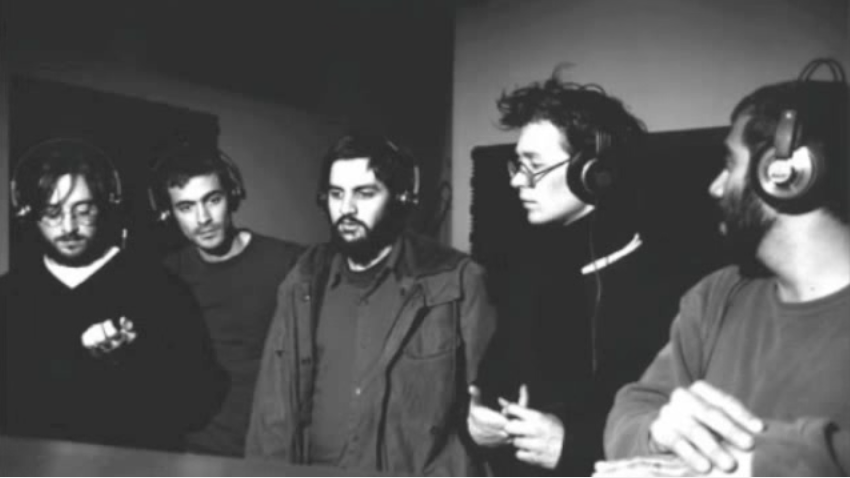A Lebanese-American Rock Musician in Texas
This article is written by Matt Kadane. He has performed or written music on over two-dozen albums, mostly with the bands Bedhead and The New Year, which released its fourth full-length album in 2017. Matt is also a history professor at Hobart and William Smith Colleges in New York and the author of The Watchful Clothier, published by Yale University Press.

What did it mean to be a Lebanese-American rock musician growing up in Texas? Culturally speaking, it didn’t mean much. We had kibbeh and tabbouleh every Sunday night at my grandparents’ house; my grandmother would occasionally throw Lebanese-themed parties; I learned how to write and speak a little Arabic; once at a junior high Halloween dance I dressed as a sheik and won first prize for costume. But none of this seemed either to impede or help playing music, at least in an obvious sense. I was never told that rock music was off limits. I also never learned how to play the oud or darabukka.

If anything mattered, it was the physical dimension of Lebanese roots. The reason I won first prize for dressing like a sheik was that the costume was almost unnecessary. In the small city where I grew up, people of Lebanese descent were relatively rare (I was the only one in my grade), and kids I knew would typically ask within minutes of meeting me, “what are you?” I understood the fuller question for what it was: “I don’t think you’re Latino”—this was Texas—“but you’re some kind of brown so what are you?” Years later a friend of mine and I developed the category of Tejano-Lebano to capture the confusion.
The point was also made in relation to music after my brother and I started a band. A friend of mine—different friend—had dinner with a fairly iconic Texas musician and told me afterwards that the icon matter-of-factly referred to my brother and me as the “Texas Towelheads.” There’s a lot to say about that, but the point here is that perceptions of the relationship between certain occupations and various kinds of identity were still rigid in the 90s. In earlier generations, people who weren’t quite white often changed their names or found other ways to make their appearance more mainstream. Lebanese-Americans were no exception. Amos Muzyad Yakhoob Kairouz became Danny Thomas. Dick Monsour became Dick Dale. Sammy Hagar dyed his hair blond.
But if the obvious message of passing was that if you were an unclear fit you should conceal the giveaway trait, the message for me, a product of a later and more accepting (if still biased) generation, was to find others who fit my self-image, or even to find ways to play that image up. To make things more complicated, even if Middle Eastern origins were implicated in the process, they didn’t always matter in and of themselves. Identity politics were never strong enough, for example, to lead me to Hagar-era Van Halen. On the other hand, half the reason I liked Pete Townshend was because of the nose. Discovering The Monochrome Set was even more of a revelation. Bid, the lead-singer, was Anglo-Indian, but that was close enough.
When it came to our own band, Bedhead—a band with two Lebanese-American brothers, a Mexican-American (Trini Martinez), a guy with white and Honduran ancestry (Kris Wheat) and an Anglo-Saxon born on the Arabian peninsula (Tench Coxe)—we grew beards, an unfashionable thing to do in the early 1990s. We had varied motives, but one was to emphasize what we were, or what we were seen to be, or for that matter what we weren’t. While bearded and on tour in Germany in the early ‘90s, the joke regularly made by our tour-mates was that Trini and I were fugitive Middle Eastern terrorists—a reference to two men who at the time were in the German papers, our same age, bearded, and on the lam. This too was a Tejano-Lebano moment with a reversal of terms—Latinos (in Germany) passing for Arabs. But we were, in any case, full participants in the joke and happy to play up our heterogeneity, which bound us more tightly together as a band.
We weren’t alone at the time in seeing a need to draw attention to common perceptions like these. We felt an unlikely affinity with the LA band NOFX when, in 1992, they released an album called White Trash, Two Heebs, and a Bean, which was one word off from a working name we had for our own band. We otherwise had nothing in common with NOFX. But that’s all the more reason the moment now seems telling: in the early 1990s it still felt necessary to say that anybody could play rock music, a point notably made (and facing far more obstacles) by the Riot grrrl bands.
But all that said, the aspect of being Lebanese-American that more deeply affected my relationship to music goes back that question, “what are you?” It was easy enough to answer at the level of ethnicity or race. When, probably in kindergarten, I first asked my dad what to say he told me: “Say you’re Lebanese, which means your family came from Lebanon, where they invented the alphabet.” But I heard the question enough to think about it in more general terms. Being—and being seen as—something else was a step to something bigger. It’s a short distance from “what am I” to the more obviously existential “who am I.” And it is that latter question, maybe more than any other, that I still turn to music to try to answer.
- Categories:


